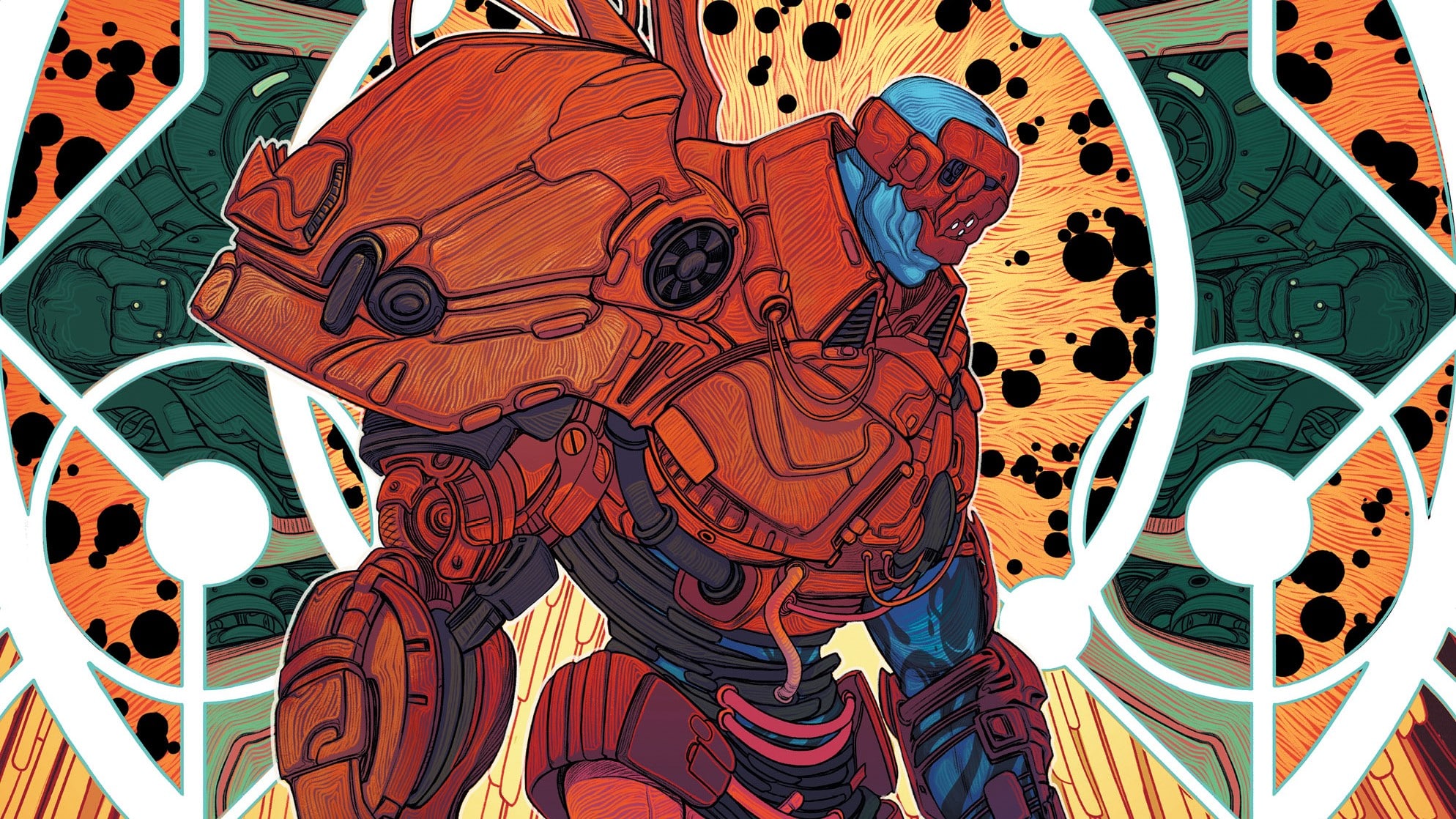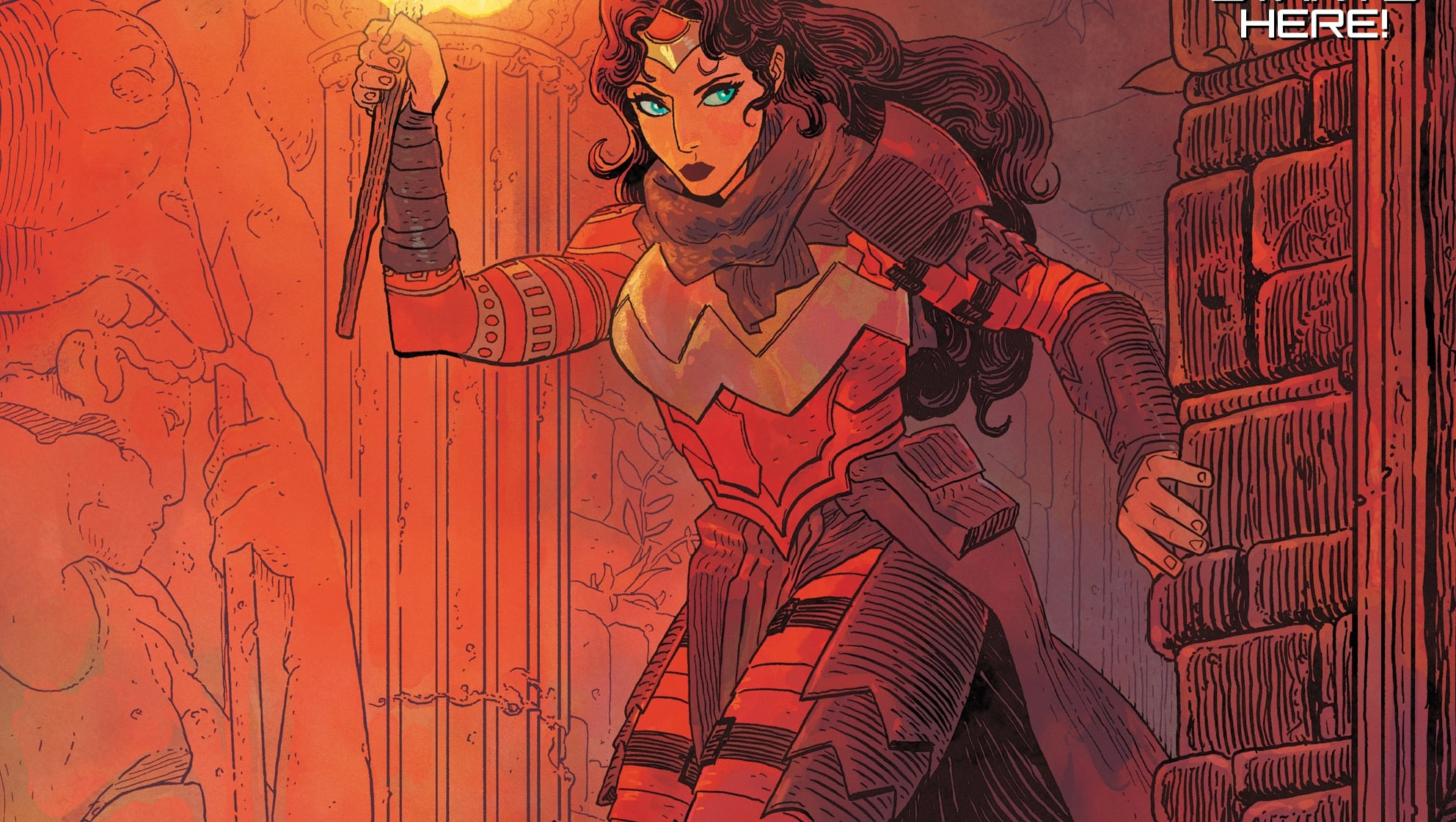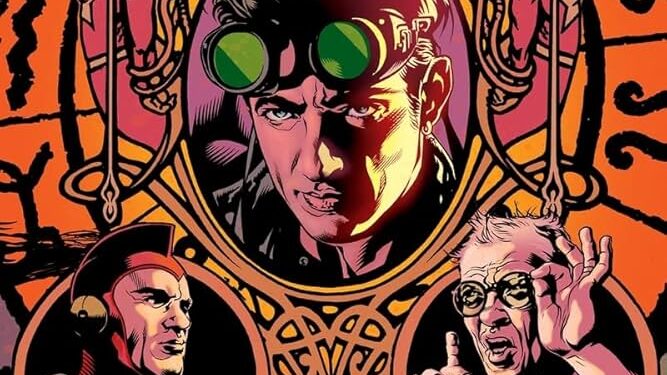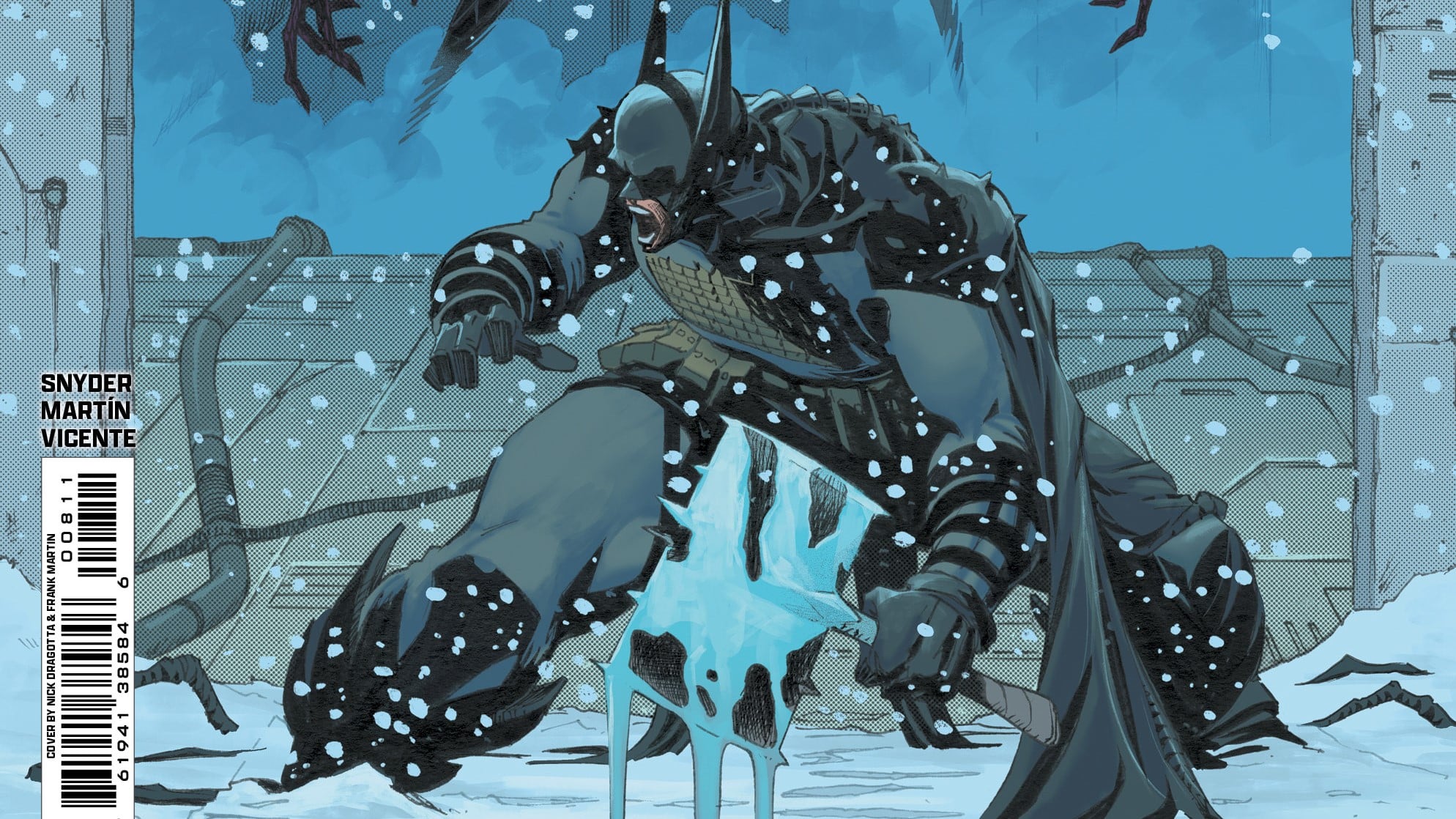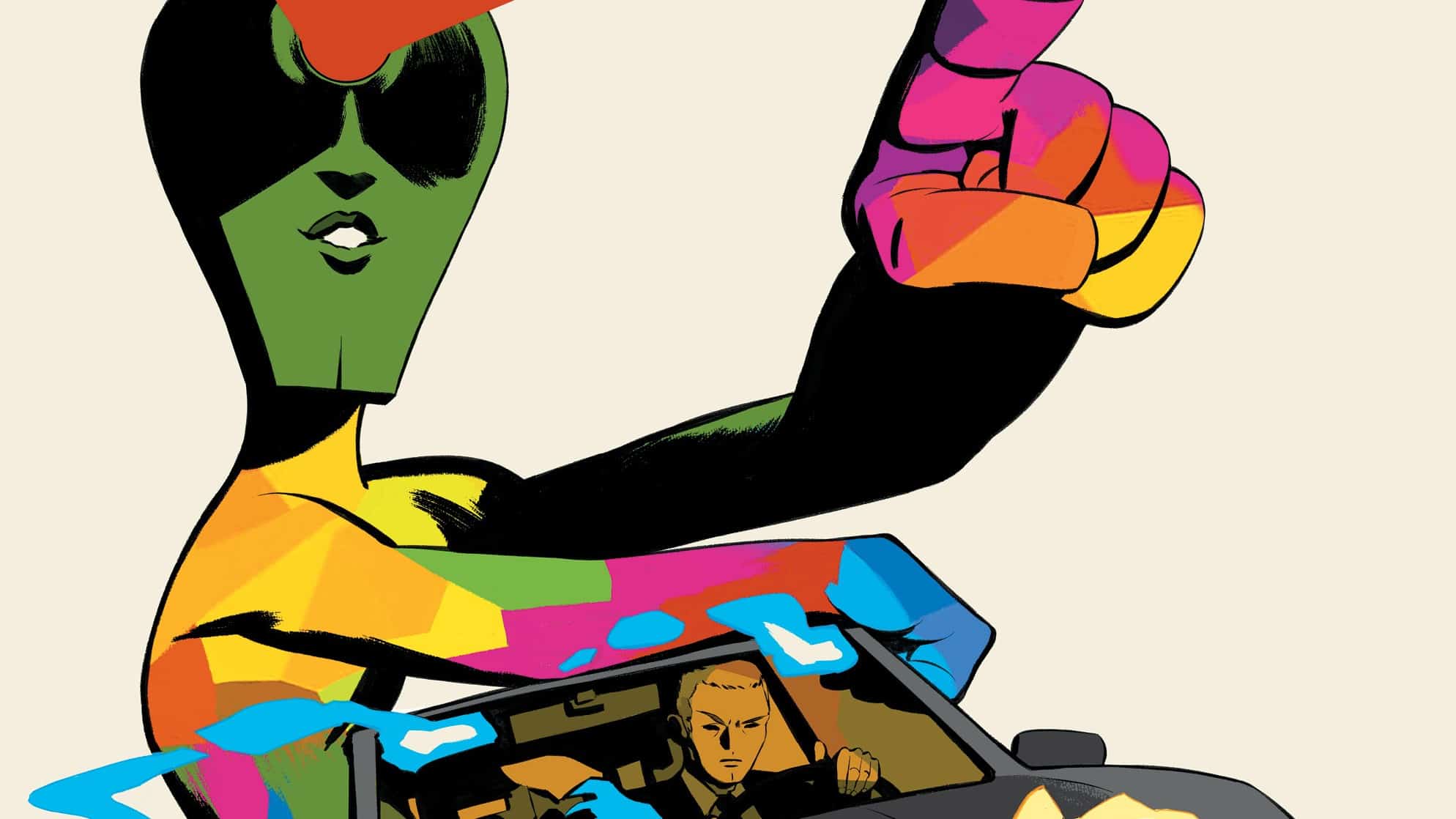Scott Free and Barda are still on the search for the child who may just bring about the end of the Fourth World, not knowing they are up against secret machinations laid down by Metron for his own mysterious ends. Before that, though, the Chronicler pulls Metron aside to tell him a story of how all this truly began, in an age long gone — with the gods of the Second World. The New Gods #3 is written by Ram V, drawn by Evan Cagle and Riccardo Federici, colored by Franceso Segala and lettered by Tom Napolitano.
Let us talk about the Fourth World.
Not the concept that Jack Kirby created, the one that gave us Darkseid and Apokolips, Mister Miracle and boom tubes, all of the wild and wonderful mythology that led to the comic we’re reading now. An age filled with conflict and sin, where civilization moves further and further away from the divine, at the end of which a great reckoning will occur to begin the cycle anew, birthing an era where new gods oversee humanity to allow us to become our best selves.
Let us talk of Kali Yuga, and how a throwaway mention of it from a fire-headed Chronicler puts this entire series into perspective, and helps me — finally — get a sense of what this comic is.
Darkness, Conflict and the End of an Era

If you’re like me, and are unfamiliar with Hindu mythology, it’s easy to miss the Kali Yuga reference. The Chronicler (a non-interfering, Watcher-like character, for all you Marvel fans out there) mentions it but once, using the words to describe all he sees when he looks out into the cosmos. With all the new mythology The New Gods introduces — the Nyctari, Amaxazu, gods from the Second World — you might just want to simply go with the flow and assume that if the term was important, it would have been expanded on. Comics aren’t meant to be homework, after all, and you shouldn’t have to google every new set of words a story throws at you.
As a critic, however, I have to, so thank you to DC for the advanced review copy so I can get this review in with just enough quick googling done to know what’s worth taking a closer look at and what isn’t.
Kali Yuga is a concept that is central to the themes The New Gods is exploring. It is part of the Yuga Cycle — four ages that start off good but get progressively worse until all is destroyed and we begin again. According to some beliefs, we are currently in Kali Yuga, which began with the death of Lord Krishna several millennia ago, and we have quite some time left before we’re all corrupted enough for Lord Shiva to destroy us all.
DC Comics’ Fourth World, then, represents the darkest part of the cycle. With dark energies released by Darkseid’s death, and the prophecy surrounding the child that shall bring about the reckoning of all, the end of the cycle appears imminent. The corrupted shall be punished, which makes the promise of a new golden age after the cycle restarts scant comfort for those alive in the here and now. It certainly explains the Highfather’s fears, and why he ordered the death of a child without a moment’s hesitation. He fears the end of all he holds dear, but more than that, he fears judgment — all his many years of sins finally catching up to him.
The signs of Kali Yuga are everywhere. Conflict has already begun. Darkseid … isn’t. Karok and the Nyctari have conquered the previously indomitable Apokolips with alarming speed, and New Genesis is the next target. On Earth, Maxwell Lord embodies the very kind of corruption that is warned against. He’s a man who not only rejects divinity but would seek to claim it for his own selfish, mundane ends — to tear godliness apart and find a way to turn it into profit. The one prophesied to bring about this age’s reckoning is alive, and walks free, coming into his own power. Simply put, the end has never been more nigh.
Of course, the events of The New Gods are not a 1:1 match for the Kali Yuga spoken of in Hinduism. In comics like The Many Deaths of Laila Starr or Rare Flavours, we’ve seen Ram V take the vast paintboxes of mythology to paint his own story with simple brushstrokes, simplifying parts of larger, more complex lore and presenting it in new ways. The New Gods uses DC’s own vastly complex mythology to similar effect, bringing in or mentioning characters like the Chronicler or Olgrun who have barely appeared in the comics before, but fit in quite comfortably here. There is a lot of love for the stories that have come before, but rather than being beholden to that lore, The New Gods reworks it for its own purposes.
The Argument Against Existence

One of the more interesting recurring concepts is the idea that the Source is not just some unique cosmic energy but information itself. Some might call it enlightenment, some, like Metron, simply think of it as the ultimate form of knowledge. The Source also has an antithesis — something that abhors life. An argument against existence. The Anti-Existence Equation, if you will (I will).
The New Gods #3 is a lore-heavy issue, crafting its own myths, as the Chronicler tells Metron the story of gods from the Second World. The three gods hold a minor reference to the Yuga Cycle here, as the second era of the cycle, the Treta Yuga, features three gods of its own — Treta being Sanskrit for “a collection of three things.” Three gods, trying to cope with the end of their own era as best they could. The god Nyctar, corrupted by a darkness that seems to be the Anti-Existence Equation, creates his own people, the Nycatri, who become an argument of their own.
The Nyctari, it would appear, are enemies of any being infused with the Source. Soldiers of the void, they are an argument against existence. They’re not a good argument, but they are a powerful one, because some arguments don’t need to be clever, convincing or even rational to be effective. They just need to have an impact.
The important thing about an argument like that is that it cannot be reasoned with, only fought against. The important thing to remember about that fight is that while the fight is necessary, it’s not who you are. It can be easy to lose yourself in that identity. Highfather has, and Orion has as well. But unlike Highfather, Orion believes there’s another way. A hope for escape. Orion, a god of the Fourth World, is putting his hopes in a miracle.
Which brings us to Mister Miracle. Scott Free. A man whose entire life has been an argument for freedom — freedom to pursue life, love, dreams and hope. We’ve seen Scott struggle with his fears of domestic life, filled with doubts about whether he can be a good father when he’s had no good example of what fatherhood looks like growing up. In this issue, we see those doubts brought back up again, through the words of a friend — Oberon, who believes Scott is not cut out for domestic life. It has to sting, coming from someone Scott is close to, to be told that everything he’s tried to escape is actually everything he’s meant to be. To be told that his dream of a happy ending is a lie, right when Scott’s doubts are at their greatest.
Oberon’s argument is simple. He knew that, sooner or later, Scott would find his way back to danger, and adventure, away from domestic bliss — and sure enough, here Scott is. In fact, if Barda hadn’t anticipated this, hadn’t insisted on coming along, Scott would have been here alone. Scott stammers his way out of discussing the issue, but as we saw in The New Gods #2, he’s torn between the life he fought for and the fight itself. He hasn’t quite figured out who he is without it.
Who Are You When the World is Ending?

This issue is especially magical. Evan Cagle’s art continues to take my breath away. With a paltry three and a half pages of action in the issue, he manages to sell dark awe in the first fight, as Apokolips is brutally conquered, and then provide a second lighthearted, dynamic, pulse-quickening scene bookending the issue. His characters are saturated with feeling, every pose, every panel telling you exactly who they are.
However, this issue is largely Ricardo Federici’s time to shine. His art is perfect for the telling of the fable of the Second World — there’s a haze to his art, melded with a realism despite the fantastical things being drawn here, that makes you feel like you’re reliving a dream. I spoke of childhood fairy tales that the first issue evoked in #1; here, the creative team doubles down on creating that feeling. When a story is old enough, it’s no mere exposition — it’s a fable. Federici is the perfect pick for this, especially given he nearly drew the First World god Olgrun’s origin in Action Comics #1043.
As for the lettering, Tom Nopalitano maintains both artists’ sense of drama, especially noticeable when you compare the Chronicler’s fable-like chalky caption boxes to the simpler house-style captions amid Cagle’s pages. Franceso Segala holds the book together — able to flip between the mythic, the mundane, the quietly exciting and the bright light of day. Colors soften and intensify depending on what the scene needs. Each page is hypnotic to look at.
I enjoyed the past two issues, but one thing they left me with is a feeling of restlessness. There’s a lot of setup — even in this issue, largely taken up by backstory that goes so far back no one can even count the years, there’s very little that actually happens. It’s not what I’m used to from a superhero comic, and I’ve been struggling to pin down exactly what this series is. It’s not an action-adventure series, or a fun romp as Barda and Scott (and Liv!) go off on adventures together. It’s not a grand, cosmic soap opera filled with the royal intrigue of the New Gods writ large across the cosmos. All those elements are there, but with this issue, I feel things finally click into place.
The New Gods is an examination of a people whose time has come. People — gods — who are forced to confront who they are, and all they’ve done, in the face of a fast-approaching reckoning. It’s an argument, one of hope, and miracles, in the face of the pervading darkness that opposes everything the New Gods stand for. It’s the promise of something new. The latest chapter of the Fourth World saga that may just lead to the Fifth — or, depending on your belief system, a new First.
I look forward to the rest of this series now without reservation, eager for what’s to come.
Buy The New Gods #3 here. (Disclaimer: As an Amazon Associate, ComicsXF may earn from qualifying purchases.)
Armaan is obsessed with the way stories are told. From video games to theater, TTRPGs to comics, he has written for, and about, them all. He will not stop, actually; believe us, we've tried.

